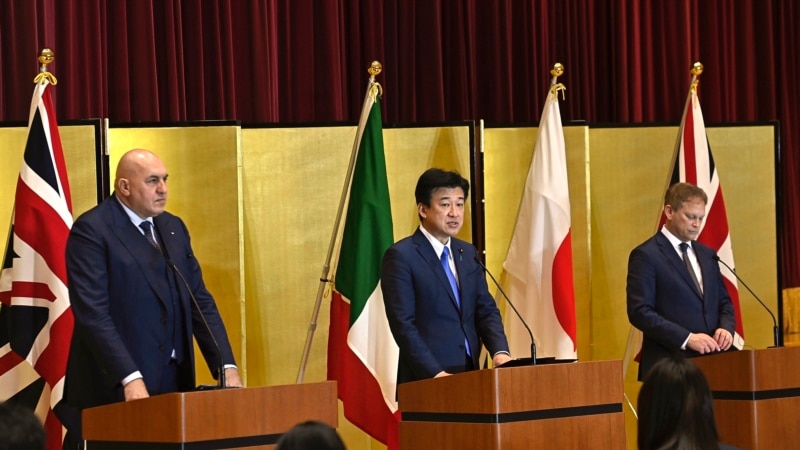
Japan’s cabinet on Tuesday approved a plan to sell future next-generation fighter jets to other countries, the country’s latest step away from the pacifist principles it adopted at the end of World War II.
The controversial decision to allow international arms sales is expected to help secure Japan’s role in a year-long project to develop a new fighter jet with Italy and Britain, but is also part of a move to build up Japan’s arms industry and bolster its capabilities. role in global affairs.
For now, Tokyo says it has no plans to export the jointly developed lethal weapons other than new fighter jets, which are not expected to enter service until 2035.
Here’s a look at the latest changes and why Japan is quickly relaxing its arms export rules.
What’s changed?
On Tuesday, the Cabinet approved revisions to its guidelines for overseas sales of defense equipment and authorized the sale of future jets. The government said it had no plans to export other jointly developed lethal weapons under the guidelines and would need cabinet approval to do so.
Japan has long banned most arms exports under the country’s pacifist constitution, although it has begun taking steps to change amid rising regional and global tensions.
In 2014, it began exporting some non-lethal military materiel, and last December it approved a modification allowing the return of 80 lethal weapons and parts it produces under license from other countries to licensors. The change, made in December, cleared the way for Japan to sell U.S.-designed Patriot missiles to the United States, helping to replace munitions shipped by Washington to Ukraine.
The decision on the jets would allow Japan to export lethal weapons it co-produces to other countries for the first time.
What is the new fighter jet?
Japan is working with Italy and the UK to develop an advanced fighter jet to replace its aging US-designed F-2 fighter jets and Eurofighter Typhoons used by the British and Italian militaries.
Japan had previously worked on a local design called FX, and in December 2022 agreed to merge its work with a British and Italian project called Tempest. The joint project, known as the Global Combat Air Programme, is based in the UK and has yet to announce a new name for its design.
Japan hopes the new aircraft will provide better sensing and stealth capabilities amid rising tensions in the region, giving it a technological edge against regional rivals China and Russia.
Why did Japan change its stance on arms exports?
In its decision, the Japanese cabinet said that the export ban of finished products will hinder the development of new aircraft and limit Japan’s support role in the project. Italy and the UK are keen to sell the aircraft to cover development and manufacturing costs.
British Defense Secretary Grant Shapps has repeatedly said that Japan needs to be “updated” to avoid stalling the project.
Kishida sought cabinet approval before signing the GCAP deal in February, but it was delayed due to resistance from his junior coalition partner, the Buddhist-backed Komeito party.
Exports will also help boost Japan’s defense industry, which has historically served only the Japan Self-Defense Forces, as Kishida seeks to bolster the military’s capabilities. Japan began opening up some exports in 2014, but the industry continues to struggle to win customers.
The change also comes as Kishida is planning a state visit to Washington in April, where he is expected to emphasize Japan’s readiness to play a greater role in military and defense industry partnerships.
Japan sees China’s rapid military buildup and growing assertiveness as a threat, especially rising tensions in the disputed East and South China Seas. Japan also regards the increasing number of joint military exercises between China and Russia around Japan as a threat.
Why are arms exports divided?
As a result of its wartime role as an aggressor and the devastation it suffered after its defeat in World War II, Japan adopted a constitution that restricted its military from self-defense and has long maintained a strict policy that limits and prohibits the transfer of military equipment and technology. All export lethal weapons.
Opposition lawmakers and peace activists have criticized Kishida’s government for committing to the fighter jet program without explaining to the public or seeking approval for major policy changes.
Recent polls show public opinion about the plan is divided.
To address these concerns, the government is currently restricting exports of jointly developed lethal weapons to the aircraft and has pledged not to sell them for use in current wars. Defense Minister Minoru Kihara said Japan would stop providing spare parts and other components if buyers started using the planes for war.
What’s next?
Potential markets for the jet include the 15 countries that have defense partnership agreements with Japan, such as the United States, Germany, India and Vietnam. Taiwan, a self-governing island claimed by China as its own territory, was not considered, a defense official said. He spoke on condition of anonymity due to briefing rules.
Under the new export guidelines, more weapons and parts may be added to the approved list.
When Kishida visits Washington in April, he is likely to discuss potential new defense and weapons industry cooperation with U.S. leaders. The new policy could also help Japan play a greater role in alliances and regional defense partnerships such as Australia, the United States and Britain’s AUKUS.
Follow us on Google news ,Twitter , and Join Whatsapp Group of thelocalreport.in
















